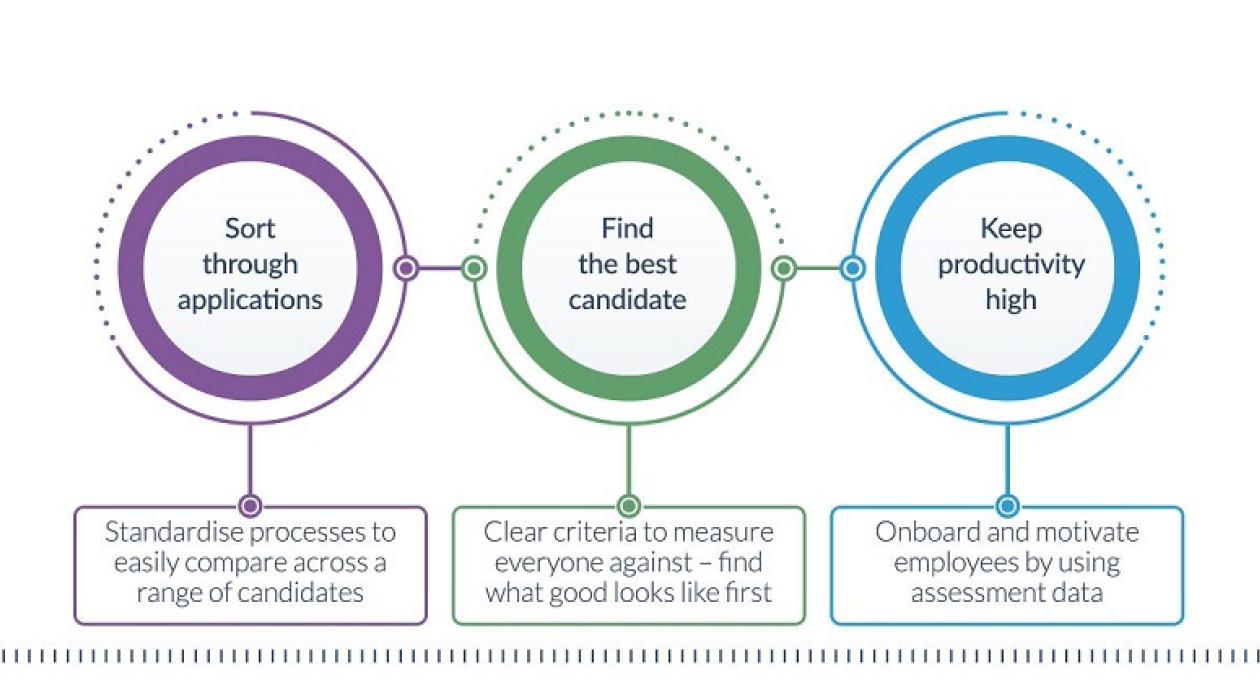As businesses look to bounce back after a difficult 2020, they’ll be looking to grow and, therefore, hire more people. However, many will likely be working with fewer resources and addressing a larger candidate pool than in previous years as a result of the pandemic.
In the face of these challenges, it’s even more critical that business leaders have the right tools and support so they can hire best-fit candidates. Predictive hiring is the concept of using data-driven analysis to determine who will be a good fit for your job role, and who is most likely to be successful in the position.
Take these 6 easy steps to integrate a predictive hiring plan into your recruitment process for better hiring success:
1. Standardise your recruitment processes across all departments
To really streamline your recruitment process, you need to level the playing field across the business. If different departments use different processes, criteria and standards to recruit against, you’re not going to be able to adopt an optimal solution.
Standardising your processes means that the data you collect will be easily comparable across a range of candidates, job roles and development plans. Setting clear criteria to measure everyone against will assist in removing biases and open up your candidate pool to more diverse, innovative talent. It also means that you’ll have clear outcomes to compare applicants and interviewees against.
Data used for predictive hiring can come from a variety of sources and collecting the right data from the start means you’re in a better position to instigate predictive methods. Gathering the same measurable data across the organisation is vital. You might want to gather facts and figures around aspects such as applications, interviews, performance, employee satisfaction and productivity.
2. Use objective data to identify what good looks like in your organisation
Knowing what good looks like for your teams is the next step in implementing predictive hiring. Understanding what data has been used in the past will help you understand how predictive hiring will help in the future. Think about the current recruitment process you have and what data is used to analyse effectiveness. For example, you could look at the following questions to help build your recruitment strategy:
- How many employees have passed probation?
- What’s the average length of employment in the company?
- How much money is being spent on recruitment?
- How many times have you recruited for the same position?
From this, you should be able to create a well-defined picture of what a good hire looks like for your organisation – what’s noticeable about those employees who passed probation compared to those that didn’t? How long do successful employees tend to stay with the company? How much should you look to spend per hire to make sure you get it right?
3. Create a clear job profile around these success criteria
Now you know what a successful hire looks like, you can use this insight to create a detailed job profile for your next vacancy.
By outlining the desired personality and behaviour traits you’ll know what motivators and drivers need to be in place for this person to succeed in the role. Understanding what level of aptitude, or general intelligence, will be required will ensure you select someone who’ll be able to handle the speed of learning required. Psychometric assessments can then deliver clear, comparable data against your desired criteria.
Thomas Assess makes creating a profile extremely quick and straightforward. It guides you through selecting the most important characteristics and requirements for the role. Then, setting the level, amount of on-the-job learning required, pace and variety of the role enables you to easily compare those to the results of applicants’ assessments results. A very simple set of star ratings shows which most closely matches your ideal candidate for the role.
4. Introduce psychometric assessments to provide an unbiased and consistent evaluation
We all have our own unconscious biases – we may not even know about them, but they’re inherent in human nature. However, when it comes to finding the best new talent for your business, bias can cause issues. 85% of CEOs whose organisations have a D&I strategy say it has enhanced business performance (PwC, 2015). A diverse workforce is more likely to drive innovation as different viewpoints are brought to the table.
The use of objective, standardised psychometric measures is one of the best ways to add a layer of objectivity into the recruitment process. The results of psychometric testing are not affected by an individual’s demographic information and therefore creates an equal and fair means to compare candidates. Using data from a psychometric test allows you to focus on only what’s important for the role and look at the key characteristics and traits of the individual to help determine fit, thus avoiding those unconscious biases creeping in.
5. Measure candidates against your preferred criteria
When you’re faced with a pile of CVs that seem difficult to distinguish between, assessments can give you an extra edge and an additional level of insight into your candidates. Now that you’ve created your ideal candidate profile, you can use data from assessments to match applicants to your role, removing the need to filter high volumes of CVs.
Thomas Assess is the ideal tool for this. Our team of psychologists has taken the complex theories and models of our assessments and mapped them to a framework of 9 characteristics. These are based on a very well-known and well-researched psychological theory – Schwartz’s Theory of Basic Values.
Selecting the three most important of these characteristics gives the Thomas platform all the information it needs to enable you to then compare your candidates’ assessment results using a very simple set of star ratings to see which most closely matches your ideal candidate for the role.
The Thomas platform also creates individually tailored interview guides for each candidate, which focus on the biggest gaps between their assessment results and the profile you created, making it even easier to find the right candidate for the role, the team and your company.
6. Make these elements a recruitment priority so you don’t miss out on the best talent
Remote working and hybrid working have widened the talent pool immensely as candidates may no longer be limited by location and commute. That means there’s more talent available for each role and you want to make sure you’re not losing out to your competitors in snapping it up, and retaining it.
Predictive hiring solutions enable HRDs and recruitment leaders to quickly identify the best candidate for any given role and rapidly progress them through the selection process, delivering clear and actionable feedback at every stage. Psychometric assessments empower employers to understand who will be the best fit for their team and company, and therefore more likely to stay once recruited. Moving faster and hiring smarter means you’re capturing the best available employee base for optimum business performance.
At Thomas, we have 40 years of experience in developing the kinds of tools required to help you select the right candidate. With a full suite of science-based models and understanding in the data-led and psychological approach to developing and discovering talent, your business will thrive with predictive hiring.
To take the next steps into predictive hiring, speak to one of our team.




